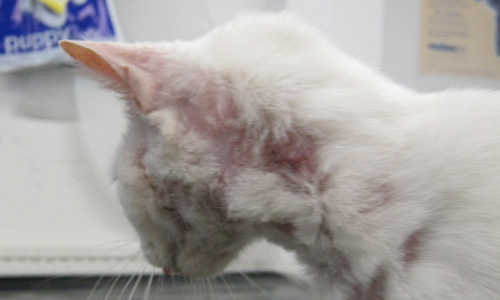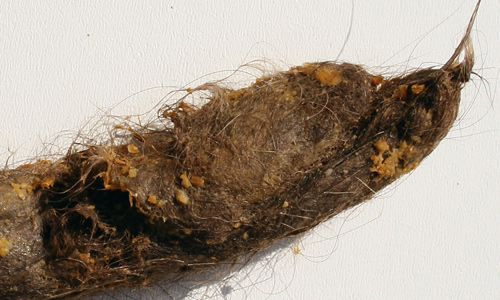Summary
Fleas are more than a nuisance. They can cause a variety of health problems for pets and people, such as disease, allergies, and anemia. This article will also summarize other irritating problems brought about by flea infestations.
Details
Disease Transmission
Fleas can be vectors for numerous diseases that affect both pets and humans. These are typically caused by bacteria. Three of the most well known are cat scratch fever (Bartonella henselae), murine typhus (Rickettsia typhi), and flea-borne spotted fever (Rickettsia felis). Fleas can also transmit illnesses that are specific to animals. These include cat flu, feline leukemia virus, and hemotropic mycoplasmas.
Bubonic Plague (Yersinia pestis) is a historically well known flea-borne illness. However, this disease is typically carried by rodent fleas, not flea species of dogs and cats. Still, cats which have consumed infected rodents could pass on plague to humans.
Tapeworms (Dipylidium caninum) can also be transmitted by fleas. Flea larvae may consume tapeworm eggs while foraging in carpets, thus becoming an intermediate host. Once it matures, the infected adult flea will find a host. The host animal can become infected with tapeworms upon consuming the flea during grooming.
Flea Allergy Dermatitis
Some animals are highly allergic to flea saliva. The extreme reactions are categorized as flea allergy dermatitis (FAD). Common symptoms of FAD are severely irritated skin and painful lesions. The irritation compels animals to excessively groom and cause self-trauma, which can lead to secondary ailments such as hair loss, skin infections, and foul odor.

Img 1 FAD on a cat, with resulting skin irritation and hair loss from grooming.
Iron Deficiency Anemia
Fleas imbibe large quantities of blood. Females feed more than males, taking in over 15 times their body weight in blood each day. However, both sexes consume more than they can digest. The excess blood is excreted as blood-laden feces to feed larvae.
Though rare, heavily-infested animals may lose so much blood that they grow anemic. Symptoms include lethargy, weight loss, and diminished appetite. Left untreated, severe infestations can cause mortality. Young animals are most susceptible to iron deficiency anemia. Most documented cases involve severely-infested calves, kids, and lambs. However, heavy infestations on kittens and puppies can also lead to anemia and death.
Diminished Overall Health
When an animal is heavily-infested with fleas, their immune system is taxed. As a result, they become vulnerable to diseases they could normally fight off, such as cat flu. Excessive grooming can further weaken the immune system, as discussed in the FAD section. With cats, more time grooming leads to more hair ingestion, and thus more frequent hairballs.

Img 2 Fleas can cause irritation and over-grooming. With cats, this can result in more hairballs.
Lost Time & Money
Controlling fleas can be expensive. Time and money are spent on flea treatments, veterinary consultation, professional pest control, etc. These costs add up. If re-infestation occurs, more treatments will be required and more resources will be lost. This is why it’s important to adhere to a proven flea control regimen, and to avoid costly common mistakes.
Fleas Bite People
Humans aren’t a preferred host of fleas. Still, people often get bit when living with an infested pet. Adults emerging from cocoons will jump to the nearest warm-bodied host. This could be a person if pets aren’t around. Red, itchy bites typically occur around the ankles.

Img 3 Humans aren’t primary hosts, but fleas may incidentally bite people when the dog or cat isn’t around.
Psychological Stress
Fleas can be perceived as a symptom of poor hygiene, or as a sign that pets are being neglected. However, flea infestations are extremely common, even in hygienic homes with caring, diligent pet-owners. Fleas don’t necessarily result from a person failing in their domestic duties. Still, these social stigmas can cause anxiety and urgency for control. Adding to this, ending an infestation can be difficult and frustrating. Patience is required, as it often takes 8 weeks to control fleas. In the meantime, the bites are itchy and annoying.
Pet & Owner Relationship
It’s easy to get irritated in the midst of a flea infestation, especially in the event of re-infestation. When emotions run hot, pets often get blamed as the cause of the problem. Then the human-animal bond gets strained. At it’s worst, this can result in the person or family getting rid of their dog or cat.
Erratic Pet Behavior
Pets, especially cats, may be reluctant to enter areas of a flea-infested home. Immature fleas usually develop in carpeting, rugs, and pet beds. By avoiding the floor where new adult fleas are emerging, pets are more likely to jump on tables, counters, and other undesirable areas.

Img 4 Pets may exhibit erratic behavior in attempt to avoid fleas.




You must log in to post a comment. Log in now.